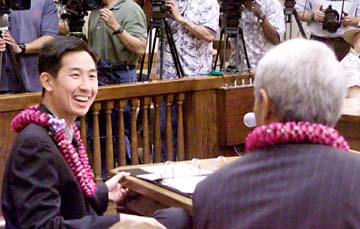
Gathering Place
By Charles Djou
CRAIG T. KOJIMA / CKOJIMA@STARBULLETIN.COM
Charles Djou, left, joked with fellow Honolulu City Council member Mike Gabbard on Jan. 2 at their swearing-in.
Adding seats would
make Council more efficientI have been told that you haven't really made it in Hawaii politics until you've been skewered by Corky Trinidad and Charley Memminger, so I guess I've made it ("Djou unafraid to djoust at windmills," Honolulu Lite, April 24). At the risk of getting skewered some more, I thought I should try to explain my "quixotic" thinking.
I certainly never shy away from proposing ideas and challenging conventional wisdom. The point I was trying to make with my Council bill to increase the number of Council seats from nine to 21 is that Hawaii government is a little "upside down" in its representation of citizens. In most locales in the United States and in Hawaii, except for Oahu, the typical democratic scheme of government is to have congressmen with big districts to handle national concerns, state legislators with slightly smaller districts to handle statewide concerns and city council members with the smallest districts to handle local concerns. On Oahu, a Honolulu City Council member represents an area five times the size of a state representative. This turns the theory of American representative democracy on its head.
As for cost, I proudly consider myself a tight pake -- I certainly have been a strong advocate for reducing government spending. The cost in the City Council is not the members themselves, but the staff. Each Council member, on average, has five staff aides, plus an additional 3 committee aides. Each of us is appropriated $250,000 for personal staff, excluding benefits and pensions. We get additional funds for committee staff. My proposal to expand the Council was explicit that the expansion would not increase the size of the legislative budget. With 21 Council members, we would not get five staff members each, but only two each.
Furthermore, under the City Charter the Council is supposed to be a part-time position. The theory is that a part-time Council member understands the community better. The current format of nine Council members with large districts yields very few true part-time council members. (And I strongly oppose increasing salaries.) What we get are independently wealthy members of the community, or people who are retired with pensions, serving as Council members. I am not sure if we get the best government when we limit the job to the retired and the wealthy.
Finally, to answer the point about increasing legislative bodies to ever-larger sizes, it is of course silly to increase the Council to 100-plus members. Nevertheless, I invite you to look at New Hampshire, a state with a population roughly the same size as Hawaii, which has a state House with 400 members. Similarly, Rhode Island, also about the same size as Hawaii, has a state House with 100 members and Vermont, with a population half the size of Hawaii's, has a 150-member House.
Sometimes, running headlong into large wind-powered alternative energy devices isn't always as insane as it may seem.
Charles K. Djou is represents District IV on the Honolulu City Council.
